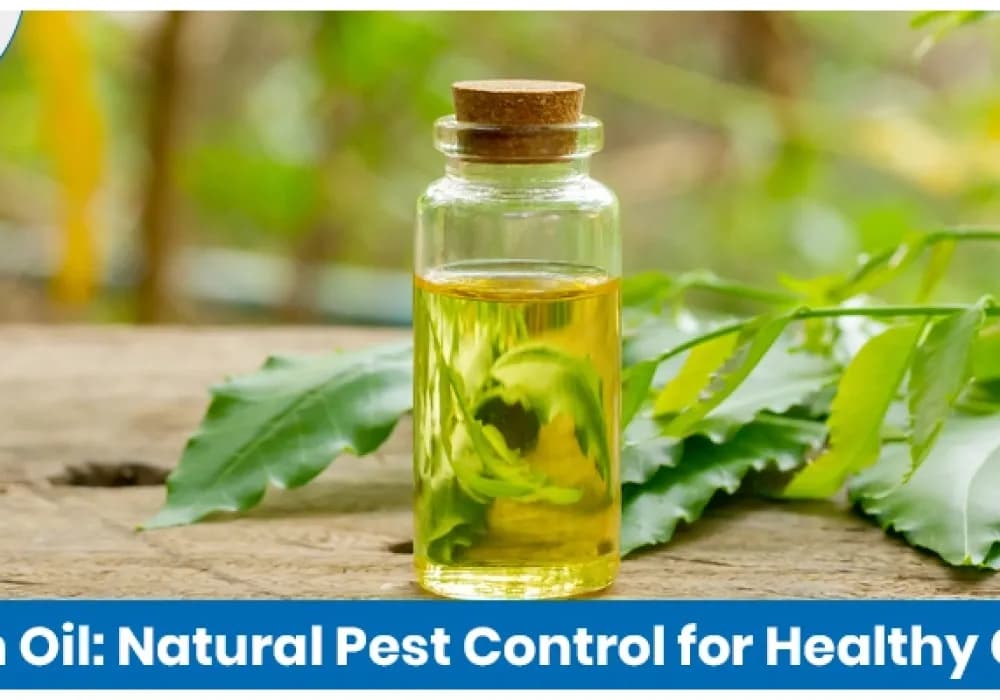Every farmer wants healthy crops without worrying about the harmful side effects of chemicals. In organic farming, controlling insects can be challenging, making natural and effective alternatives to chemical pesticides crucial for maintaining crop health and promoting environmental sustainability.
One of the most powerful solutions is neem oil, a plant-based extract derived from the seeds of the neem tree (Azadirachta Indica). The most unique aspect of neem oil is that it not only kills pests immediately, as chemicals do, but it also slows them down in their feeding, interferes with their growth, and prevents them from multiplying.
Farmers in India are increasingly adopting this eco-friendly approach to protect their crops, enhance soil health, and preserve biodiversity, all while ensuring that crop yield and food safety are not compromised. In this blog, we will explore its capabilities, the pests it controls, and the process for preparing and applying neem oil safely.
What is Neem Oil and Why Is It Effective Against Insects
Neem oil is a natural extract from the seeds of the neem tree, widely used by farmers in India. Its key active compound, azadirachtin, does not act like chemical sprays that kill pests instantly. Due to its antifungal, insecticidal, and antibacterial properties, neem oil is considered one of the most sustainable agricultural practices. This causes insects to stop feeding, slows their growth, and prevents them from multiplying.
Additionally, neem oil does not harm your soil, crops and other beneficial insects. This is why neem oil has emerged as the most ideal alternative for farmers in organic farming, as it is a natural, inexpensive, and safe option.
Common Pests Controlled by Neem Oil in Indian Crops
Neem oil is one of the popular natural pesticides that help in safeguarding diverse crops in India. Its unique chemical (azadirachtin), not only repels insects but also restricts their growth and reproduction. This makes it effective against both chewing and sucking pests.
Why Farmers Prefer it:
The best thing is that neem oil doesn’t harm beneficial insects, such as bees, butterflies, and ladybirds, which are essential for the pollination process. Unlike chemical sprays and solutions, it balances the soil health by protecting crops from pests and keeping the healthy insects safe.
Let's consider several important crop groups:
|
Crop |
Pests Controlled by Neem Oil |
How Neem Oil Helps |
|---|---|---|
|
Rice (Paddy) |
Brown planthopper (BPH), stem borer, leaf folder |
Reduces feeding and reproduction, lowers pest spread |
|
Vegetables (tomato, brinjal, chilli, okra) |
Fruit borer, leaf miner, aphids, whiteflies |
Repels pests, prevents egg-laying, protects tender shoots & fruits |
|
Cotton |
Whiteflies, jassids, mealybugs |
Weakens sucking pests, reduces crop yellowing, and prevents virus transmission |
|
Pulses (red gram, green gram, chickpea) |
Pod borer, aphids, other sucking pests |
Prevents pod damage, improves grain filling, and increases yield |
|
Fruit Crops (mango, guava, banana, citrus, grapes) |
Mealybugs, scale insects, and caterpillars |
Controls sticky infestations, protects fruit quality, leaves no residue |
How to Prepare a Neem Oil Spray
1) Assemble Your Supplies:
- Neem Oil: Use cold-pressed neem oil to retain the full neem value that becomes lost in other processing methods.
- Mild Soap or Liquid Detergent: Acts as an emulsifier (assists in the combination of oil, and in most cases, water).
- Clean Water: Prefer fresh water; hardness has to be in reasonable quantities.
2) Standard Mixing Ratio:
- Neem oil: 5 ml (1 teaspoon)
- Liquid soap: 2–3 ml (about ½ teaspoon)
- Water: 1 liter
- This proportion yields a safe and effective neem oil spray suitable for use on most crops and garden plants.
3) Step-by-Step Mixing:
- Take a small bowl or cup. Combine and mix the neem oil and the soap to create a milky solution (emulsion).
- This can then be slowly poured into the 1 liter of water.
- Stir or shake the water and oil on several occasions until the solution is uniform (visible oil does not float separately).
- Stir or shake the mixture several times until it is uniform, with no visible oil floating on the surface.
Important Things to Consider While Preparing
- Always mix a fresh solution before spraying. Do not store it for the following day, as neem loses its effectiveness in a short time.
- If you need to mix bigger amounts (for farms), use the same ratio of 50 ml neem oil + 20 to 25 ml soap for 10 liters of water.
- Use natural or mild soaps only; harsh soaps containing detergents should be avoided, as they may be detrimental to the plants.
- This means that the neem oil can be evenly distributed onto the leaves and pests for maximum effectiveness.
What are the Advantages of Using Neem Oil as an Insecticide?
Neem oil has gained recognition as a beneficial insecticide, particularly in organic and sustainable gardening practices. The key advantages are the following:
1) Natural and Eco-Friendly
Biodiversity-friendly and sustainable neem oil is extracted from the seeds of the new tree, hence undergoes no chemical intervention, and is completely eco-friendly and biodegradable unlike chemical pesticides, neem oil does not have long-term damaging residues in the soil, water, and crops, making it extremely suitable for organic gardening.
2) Effective Against a Wide Range of Pests
Neem oil is highly effective in the field of pest control and is known for its speed and ability to target a variety of pests, including aphids, whiteflies, caterpillars, leaf miners, mealybugs, and mites. This makes neem oil a valuable tool for farmers cultivating a diverse range of crops.
3) Multiple Modes of Action
Besides directly affecting pests, neem oil prevents them from feeding, reproducing, or developing. An insect that encounters neem oil may stop eating, be unable to molt, and be unable to lay eggs. This population is effectively controlled if there is in demand for the oil.
4) Supports Integrated Pest Management
This type of oil is beneficial and does not conflict with other biological or cultural pest control methods. Integrated pest management systems benefit from the fact that they are less damaging to beneficial bugs and natural predators.
Conclusion:
Neem oil is one of the most relied-upon natural remedies among farmers who desire to manage pests without using toxic chemicals. Unlike synthetic sprays that kill pests instantly, neem oil works intelligently by preventing pests from feeding, breeding, and growing.
It implies that crops will be safer for longer, and the health of the soil, water, and beneficial insects such as bees and earthworms will not be harmed. It is an inexpensive, easy-to-use, and environmentally friendly instrument that any farmer can employ.
Neem oil offers the ideal balance between crop protection and natural protection for those who practice organic farming. It does not cause any harmful residues, can be applied on a very broad range of crops, and makes chemical pesticides less expensive.
FAQs

K SANJEEVA REDDY
CHIEF AGRONOMY OFFICER
Sanjeeva Reddy K. serves as the Chief Agronomy Officer at AGRIBEGRI TRADELINK PVT LTD, a role he stepped into in July 2025, where he oversees and manages agronomy expertise across the organization. He holds a Postgraduate degree in Agricultural Science from Tamil Nadu Agricultural University, India, and is a Certified Crop Advisor accredited by the Indian Society of Agri Professionals, in association with the American Society of Agri Professionals. With more than 20 years of experience in crop production, Reddy has built extensive expertise working across reputed agribusiness industries. A significant part of his career includes a decade-long tenure with the internationally recognized Indian brand MULTIPLEX, a leading Bangalore-based manufacturer and marketer of plant nutrients, where he played a key role in driving growth and innovation.
